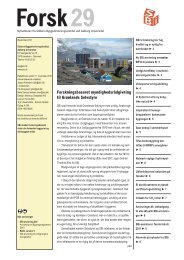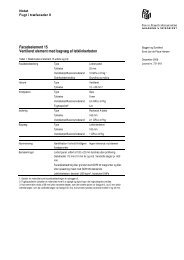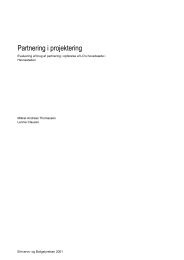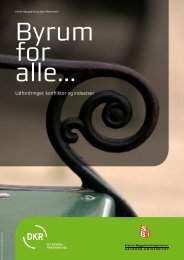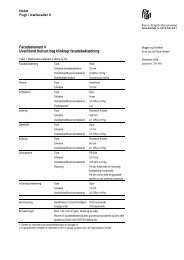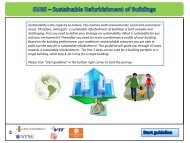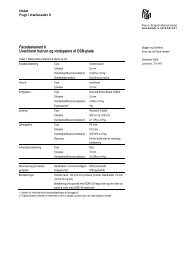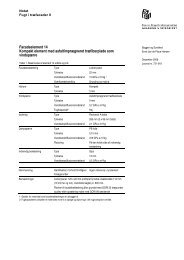See paper in PDF
See paper in PDF
See paper in PDF
Create successful ePaper yourself
Turn your PDF publications into a flip-book with our unique Google optimized e-Paper software.
The European Community Initiative URBAN:<br />
help or h<strong>in</strong>der for local participation?<br />
The case of URBAN Bijlmermeer (Amsterdam, the Netherlands)<br />
DRAFT<br />
Work <strong>in</strong> progress - please do not quote without permission<br />
Drs. Thea Dukes M.A.<br />
University of Amsterdam<br />
Faculty of Social and Behavioural Sciences<br />
Department of Geography and Plann<strong>in</strong>g<br />
AME Amsterdam study centre for the Metropolitan Environment<br />
Nieuwe Pr<strong>in</strong>sengracht 130<br />
1018 VZ Amsterdam<br />
the Netherlands<br />
phone +31 20 525 4013<br />
fax +31 20 525 4051<br />
email t.dukes@frw.uva.nl<br />
Paper presented at the conference Area-based <strong>in</strong>itiatives <strong>in</strong> contemporary<br />
urban policy, Danish Build<strong>in</strong>g and Urban Research and European Urban<br />
Research Association, Copenhagen 17-19 May 2001.<br />
1
Introduction<br />
In 1995 the Amsterdam Bijlmermeer neighbourhood, a part of the Southeast<br />
district, was assigned fund<strong>in</strong>g by the European Commission, with<strong>in</strong> the context<br />
of the Community Initiative URBAN. One of the program requirements<br />
was an organizational structure, composed of a Steer<strong>in</strong>g Committee and a<br />
Supervisory Committee. However, from the outset, there was a public outcry<br />
by the local (primarily) ‘black’ population, aga<strong>in</strong>st this organizational structure.<br />
Especially the one-sided, ma<strong>in</strong>ly ‘white’ composition of the URBAN organizational<br />
structure, as well as the m<strong>in</strong>or representation of ethnic m<strong>in</strong>ority<br />
groups and neighbourhood residents were heavily criticized. Many of the<br />
Southeast District councilors shared this op<strong>in</strong>ion and supported the protest.<br />
The protest resulted <strong>in</strong> a heated discussion, that has become known as the<br />
‘black and white discussion’ and that caused a huge delay <strong>in</strong> the implementation<br />
of the URBAN program <strong>in</strong> the Bijlmermeer: from May 1996 until January<br />
1997 there was a program ‘time-out’. However, the result of this discussion<br />
was a significant change <strong>in</strong> the organizational structure, as well as a serious<br />
shift with respect to the content of the orig<strong>in</strong>al URBAN Bijlmermeer<br />
program.<br />
The questions that I would like to address <strong>in</strong> this <strong>paper</strong> are: what were the<br />
orig<strong>in</strong>al po<strong>in</strong>ts of departure of the URBAN Bijlmermeer program? What precisely<br />
caused this public outcry and how did the discussion develop? And f<strong>in</strong>ally,<br />
what was the outcome, especially <strong>in</strong> terms of ga<strong>in</strong>s for the local population?<br />
To what extent could the <strong>in</strong>creased participation be ascribed to the<br />
Community Initiative URBAN?<br />
The <strong>in</strong>formation is derived from the case study that I am presently work<strong>in</strong>g<br />
on with<strong>in</strong> the framework of the European UGIS-program, <strong>in</strong> which several<br />
EU member states participate. The more general question, at the beg<strong>in</strong>n<strong>in</strong>g<br />
of the case study was: How has the presence of the Community Initiative<br />
URBAN changed the <strong>in</strong>terplay between the various actors <strong>in</strong>volved <strong>in</strong> the<br />
program? As this case study has not been f<strong>in</strong>ished yet, you have to keep <strong>in</strong><br />
m<strong>in</strong>d that much of the follow<strong>in</strong>g material is quite prelim<strong>in</strong>ary. In my PhD research<br />
I will exam<strong>in</strong>e some rema<strong>in</strong><strong>in</strong>g questions <strong>in</strong> more detail.<br />
First of all, I would like to briefly <strong>in</strong>troduce the Bijlmer neighbourhood and<br />
the Community Initiative URBAN.<br />
2
The Bijlmer neighbourhood<br />
The City of Amsterdam is subdivided <strong>in</strong> fifteen districts. Every district is<br />
headed by its own adm<strong>in</strong>istration. One of these districts, called ‘Amsterdam<br />
Zuidoost,’ (‘Amsterdam Southeast’) is located to the southeast of the City of<br />
Amsterdam. It can be characterized as a peripheral new social hous<strong>in</strong>g estate.<br />
The area to which is usually referred as ‘the Bijlmer’ or ‘the Bijlmermeer,’<br />
is part of this district and is home to almost 50.000 people.<br />
The Bijlmer construction, which started <strong>in</strong> 1966, attracted worldwide attention,<br />
as it concerned a large scale, and therefore unique ‘functional town’,<br />
based on the concept of the architect Le Corbusier. In the lay-out of this<br />
functional town, liv<strong>in</strong>g, work<strong>in</strong>g, traffic and recreation were separated. The<br />
Bijlmer ma<strong>in</strong>ly consisted of high-rise (10-floor) deck-access apartment blocks<br />
<strong>in</strong> a honeycomb pattern. Of the total of 18,000 units, 13,000 were built <strong>in</strong> this<br />
way. Between the large, high-rise apartment blocks, spacious green parks<br />
were developed, traversed by bicycle and pedestrian routes. Car traffic was<br />
led above ground level and metro l<strong>in</strong>es crossed the roadways (Projectbureau<br />
Vernieuw<strong>in</strong>g Bijlmermeer, 1994; Stadsdeel Zuidoost et al., 1995; UBO<br />
URBAN Bijlmermeer, 1999).<br />
The spacious and comfortable high-rise apartments, mostly developed as<br />
public hous<strong>in</strong>g, were <strong>in</strong>tended for (lower) middle-class families from the old<br />
<strong>in</strong>ner city areas of Amsterdam. However, soon after the Bijlmer construction<br />
had started, it became already clear that the way of build<strong>in</strong>g (high-rise<br />
blocks) was not <strong>in</strong> accordance with the markets; the people for whom it was<br />
meant did not move to the Bijlmer. This resulted <strong>in</strong> a lack of occupancy.<br />
Moreover, these vacant apartments attracted many people who for some<br />
reason could not easily f<strong>in</strong>d a place to live elsewhere. Between 1970 and<br />
1975, preced<strong>in</strong>g the <strong>in</strong>dependence of Sur<strong>in</strong>am (a former colony of the Netherlands),<br />
many Sur<strong>in</strong>amese came to the Netherlands and settled <strong>in</strong> the<br />
Bijlmer. Other immigrants, from the Netherlands Antilles, followed. In the<br />
middle of the 1980s, many fr<strong>in</strong>ge groups, such as refugees, migrants, illegal<br />
foreigners, and so on, found refuge <strong>in</strong> the Bijlmer area. As rents were high,<br />
people shared dwell<strong>in</strong>gs, which caused overpopulation <strong>in</strong> some blocks. Especially<br />
among the ethnic m<strong>in</strong>ority groups, the educational level was low and<br />
the level of unemployment considerable. People who could afford it, left the<br />
Bijlmer area and were replaced with an <strong>in</strong>flux of deprived, many of whom<br />
newcomers. Whereas the area had become known for its unique spatial organization<br />
(separation of traffic, the lay out of (semi-) public space), this particular<br />
spatial organization turned out to promote and support un-safety,<br />
vandalism, and an <strong>in</strong>creas<strong>in</strong>g drug abuse (Projectbureau Vernieuw<strong>in</strong>g<br />
Bijlmermeer, 1994; Stadsdeel Zuidoost et al., 1995; UBO URBAN Bijlmermeer,<br />
1999). In the 1980s measures were taken to improve the Bijlmermeer<br />
situation.<br />
Exam<strong>in</strong><strong>in</strong>g the ethnic composition of the population, the Bijlmer is characterized<br />
by a large diversity of people: more than 80 different cultures are<br />
represented <strong>in</strong> this area. In 1996, the year of the ‘black and white discussion,’<br />
the share of ethnic m<strong>in</strong>ority groups <strong>in</strong> the Bijlmer area was already almost<br />
twice the share of these groups <strong>in</strong> the city of Amsterdam. The Dutch,<br />
on the other hand, made up less than a quarter of the total Bijlmer population.<br />
The largest ethnic m<strong>in</strong>ority group consisted of Sur<strong>in</strong>amese and Antillean<br />
<strong>in</strong>habitants: <strong>in</strong> 1996 their share was 43 percent of the total Bijlmer<br />
population. Moreover, these groups made up more than half (56 percent) of<br />
the ethnic m<strong>in</strong>ority groups <strong>in</strong> the Bijlmer. Another category that was quite<br />
substantial consisted of ethnic m<strong>in</strong>ority groups from non-<strong>in</strong>dustrialized coun-<br />
3
Sur<strong>in</strong>amese<br />
or Antillean<br />
tries (such as Africa, South America, Asia and eastern and southern<br />
Europe): <strong>in</strong> 1996 they made up about a quarter of the total Bijlmer population.<br />
Table 1: Ethnic m<strong>in</strong>ority groups <strong>in</strong> Amsterdam city and <strong>in</strong> the Bijlmer neighbourhood, as a proportion of<br />
the total population <strong>in</strong> the areas concerned, <strong>in</strong> 1996 (<strong>in</strong> percentages):<br />
Turkish Moroccan Southern<br />
European<br />
Others from<br />
Non-<strong>in</strong>dustr.<br />
Countr.<br />
Others from<br />
Industr.<br />
Countries<br />
Bijlmer 42,9% 1,7% 1,8% 1,6% 23,4% 4,9% 23,6% 100,0%<br />
Ams 11,1% 4,3% 6,7% 2,3% 8,3% 9,7% 57,6% 100,0%<br />
Source: O+S, 1996<br />
Dutch<br />
Total<br />
4
The Bijlmermeer renewal operation<br />
Over time and due to a comb<strong>in</strong>ation of factors, the Bijlmer became one of<br />
the most problematic neighbourhoods <strong>in</strong> the Netherlands. The results of the<br />
measures that had been taken <strong>in</strong> the 1980s turned out to be disappo<strong>in</strong>t<strong>in</strong>g:<br />
the Bijlmermeer image rema<strong>in</strong>ed poor, the economic position of the population<br />
did not really improve. In July 1992, the Southeast District Council, the<br />
Nieuw Amsterdam hous<strong>in</strong>g corporation and the Amsterdam municipality settled<br />
for a large-scale <strong>in</strong>tegral renewal operation of the Bijlmermeer<br />
(Stadsdeel Zuidoost, 1995). The ma<strong>in</strong> purpose of the Bijlmermeer renewal<br />
operation was a revaluation of the Bijlmermeer <strong>in</strong> order to create a neighbourhood<br />
with a favourable liv<strong>in</strong>g climate. Initially it was primarily spatial renewal<br />
that was attended to, as it was judged to have the best chance of success<br />
<strong>in</strong> prim<strong>in</strong>g the Bijlmer renewal operation (Stadsdeel Zuidoost, 1998).<br />
But at the same time, a wide audience supported the understand<strong>in</strong>g that social-economic<br />
renewal should be undertaken as well.<br />
In the summer of 1994, the Amsterdam municipality was <strong>in</strong>formed that an<br />
application for fund<strong>in</strong>g could be submitted with the European Commission,<br />
with<strong>in</strong> the framework of the Community Initiative URBAN. Because of its<br />
emphasis on social-economic renewal activities, this European program<br />
would perfectly match with the needs <strong>in</strong> the Bijlmermeer. The Dutch government<br />
responded to the appeal and submitted a request for fund<strong>in</strong>g of the<br />
Bijlmermeer. In September 1995, the European Commission approved the<br />
‘URBAN Bijlmermeer program.’ F<strong>in</strong>ancial support for the program would be<br />
derived from the European Fund for Regional Development (ERDF) and the<br />
European Social Fund (ESF), on the basis of co-f<strong>in</strong>anc<strong>in</strong>g. Projects had to<br />
be tendered before December 31st, 1999. At about the same time that the<br />
European Commission approved the URBAN Bijlmermeer program, the<br />
news got out that (partly because of the URBAN condition of co-f<strong>in</strong>anc<strong>in</strong>g)<br />
the Dutch national government would f<strong>in</strong>ancially support the Bijlmer renewal<br />
operation as well, with<strong>in</strong> the Major Cities Policy framework (Stadsdeel<br />
Zuidoost, 1998).<br />
5
The Community Initiative URBAN<br />
The Community Initiative URBAN (or briefly: ‘URBAN’) was launched by the<br />
European Commission <strong>in</strong> 1994, <strong>in</strong> order to contribute to the search for solutions<br />
for the high concentration of social, environmental and economic<br />
problems that were <strong>in</strong>creas<strong>in</strong>gly present <strong>in</strong> urban agglomerations. URBAN<br />
targets neighbourhoods <strong>in</strong> extreme deprivation and is known for its <strong>in</strong>tegrated<br />
approach, <strong>in</strong> the sense that it takes account of all dimensions of urban<br />
life. Further, URBAN programs are characterized by divergent measures,<br />
such as the launch of new economic activities, the promotion of local<br />
employment and improvements of the environmental <strong>in</strong>frastructure. Another<br />
characteristic, of major importance for for this presentation, is a considerable<br />
emphasis on local participation <strong>in</strong> the design and implementation of the program<br />
- the problems of urban deprivation are to be solved at the grass-roots<br />
level. F<strong>in</strong>ally, the URBAN Community Initiative pursues a spatially focused<br />
approach, <strong>in</strong> which one neighbourhood or adm<strong>in</strong>istrative district is targeted<br />
at the time. In the case of Amsterdam, the target area was the Bijlmermeer<br />
(European Commission, 1998).<br />
The URBAN Bijlmermeer program had to be <strong>in</strong>tegrated <strong>in</strong> the ongo<strong>in</strong>g social-economic<br />
renewal operation <strong>in</strong> the Bijlmermeer that had started <strong>in</strong> 1992.<br />
What did the program look like <strong>in</strong> 1995, with regard to the actors <strong>in</strong>volved,<br />
their responsibilities, the organizational structure and the f<strong>in</strong>ancial arrangements?<br />
Actors <strong>in</strong>volved and responsibilities<br />
Several policy levels were <strong>in</strong>volved <strong>in</strong> the URBAN Bijlmermeer program:<br />
– the European Commission, that was the <strong>in</strong>itiator en co-f<strong>in</strong>ancier of the<br />
program. Through the European rules regard<strong>in</strong>g the way <strong>in</strong> which the<br />
URBAN-programs had to be dealt with, the European Commission had a<br />
dom<strong>in</strong>ant <strong>in</strong>fluence on the realization and implementation of the URBAN<br />
programs, even though these were only partly f<strong>in</strong>anced with European<br />
funds (ERAC, 1998);<br />
– the M<strong>in</strong>istry of Internal Affairs, that was a co-f<strong>in</strong>ancier of the programs<br />
as well, via the Major Cities Policy funds. This M<strong>in</strong>istry was the contact<br />
po<strong>in</strong>t for the European Commission (or better: for the responsible European<br />
Directorates), and was hold responsible on behalf of the Netherlands<br />
for a correct implementation of the Dutch URBAN-programs. This<br />
M<strong>in</strong>istry further played an important role <strong>in</strong> formulat<strong>in</strong>g rules for the UR-<br />
BAN programs <strong>in</strong> the Netherlands, <strong>in</strong> agreement with the European rules<br />
(ERAC, 1998; NEI,1999).<br />
– the Amsterdam city council and the Southeast district council; both<br />
government levels <strong>in</strong>fluenced the decision mak<strong>in</strong>g regard<strong>in</strong>g the allocation<br />
of URBAN money. The Amsterdam city council had the f<strong>in</strong>al responsibility<br />
for the spend<strong>in</strong>g of URBAN-money <strong>in</strong> the Bijlmermeer (Van der AA,<br />
1996). The Southeast district council was responsible for the development<br />
of the programs and the projects.<br />
– F<strong>in</strong>ally, several employees work<strong>in</strong>g with public services at divergent<br />
governmental levels were <strong>in</strong>volved <strong>in</strong> the implementation of the URBAN<br />
Bijlmermeer program (<strong>in</strong> the ‘program management’ for example).<br />
6
Apart from these political levels, all k<strong>in</strong>ds of other organizations were <strong>in</strong>volved<br />
<strong>in</strong> URBAN Bijlmermeer as well, such as the Chamber of Commerce,<br />
hous<strong>in</strong>g associations, the police, an educational consultative body, and so<br />
on. Strik<strong>in</strong>gly, the majority of the actors <strong>in</strong>volved consisted of public or semipublic<br />
actors.<br />
Organizational structure<br />
Accord<strong>in</strong>g to European guidel<strong>in</strong>es, an organization had to be set up, that<br />
would be responsible for the allocation of money to URBAN projects. On the<br />
other hand, though, the URBAN program had to be <strong>in</strong>tegrated <strong>in</strong> the ongo<strong>in</strong>g<br />
renewal operation <strong>in</strong> the Bijlmermeer. In the result<strong>in</strong>g organization structure,<br />
as set up <strong>in</strong> 1995, both requirements were thus taken <strong>in</strong>to account. It looked<br />
as follows (Comité van Toezicht, 1997):<br />
Supervisory Committee<br />
URBAN Bijlmermeer<br />
Steer<strong>in</strong>g Committee<br />
Social-Economic<br />
Renewal<br />
Program Management<br />
Urban Bijlmermeer<br />
Project groups<br />
Social-Economic Renewal<br />
The Supervisory Committee was <strong>in</strong> charge of the implementation of the<br />
URBAN Bijlmermeer program. On behalf of the Amsterdam municipality, alderman<br />
Jaap van der Aa, who was responsible for the ethnic m<strong>in</strong>orities-,<br />
education-, social affairs- and employment-portfolio, was appo<strong>in</strong>ted chairman<br />
of this Committee. Other seats were reserved for representatives from<br />
other political levels (the European Directorate-Generals V and XVI (2), the<br />
M<strong>in</strong>istry of Internal Affairs (2), the Southeast district (3), as well as for delegates<br />
from (semi-) public <strong>in</strong>stitutions, such as a hous<strong>in</strong>g association (1), the<br />
police (1), the Chamber of Commerce (1) and an educational consultative<br />
body (1).<br />
In October 1995, the Supervisory Committee established the Steer<strong>in</strong>g<br />
Committee Social-Economic Renewal. This Committee was authorized to<br />
approve the <strong>in</strong>dividual project proposals that were submitted for European<br />
fund<strong>in</strong>g. This Committee was presided by a representative of the Southeast<br />
district, but formerly mentioned alderman Van der Aa participated as a<br />
member <strong>in</strong> the Steer<strong>in</strong>g Committee as well. Altogether, the seats were reserved<br />
for the Southeast district (2, <strong>in</strong>clud<strong>in</strong>g the chair), the Amsterdam municipality<br />
(1), a hous<strong>in</strong>g association (1), the Chamber of Commerce (1), an<br />
educational consultative body (1) and the police (1).<br />
Exam<strong>in</strong><strong>in</strong>g the composition of the two Committees, it is strik<strong>in</strong>g that neighourhood<br />
organizations, ethnic- or religious organizations were not represented<br />
at all. Even though the Community Initiative URBAN emphatically<br />
<strong>in</strong>tended to stimulate local participation (see page 6.)<br />
A Program Management that supported the earlier mentioned Committees<br />
was established as well. This office was responsible for the daily course<br />
of events related to the implementation of the program.<br />
F<strong>in</strong>ally, four project groups were established, related to work, social development,<br />
quality of life and public security. The chairs and the secretaries<br />
of the project groups came from the Southeast district services.<br />
7
F<strong>in</strong>anc<strong>in</strong>g<br />
The URBAN money for the Bijlmermeer, derived from the European Structural<br />
Funds, consisted of about 10 million guilders. However, as mentioned<br />
earlier, co-f<strong>in</strong>anc<strong>in</strong>g of the projects was necessary, as the European Commission<br />
did not reimburse more than about half of the project costs (Bureau<br />
SEV, 1998). Based on this condition, the Dutch national government made<br />
16.5 million guilders available with<strong>in</strong> the Dutch framework of Major Cities<br />
Policy (GSB). The total amount of money, made available by the European<br />
Commission and the Dutch national government is presented <strong>in</strong> the table<br />
below.<br />
Table 2: Amount of money, made available by the European Commission and the Dutch national government<br />
for URBAN Bijlmermeer (<strong>in</strong> guilders).<br />
European Regional Development Fund (ERDF) f 7.848.200,00<br />
European Social Fund (ESF) f 2.001.800,00<br />
Contribution of the Dutch national government,<br />
as co-f<strong>in</strong>anc<strong>in</strong>g for the European ERDF/ESF<br />
contributions<br />
(GSB-I) f 10.352.500,00<br />
Money from the Dutch national government (not<br />
co-f<strong>in</strong>anc<strong>in</strong>g) (GSB-II) (About) f 6.500.000,00<br />
Source: Comité van Toezicht, 2000<br />
Usually, when is spoken of the “Urban Funds’ for the social-economic<br />
Bijlmermeer renewal, the total amount of about f 26.5 million guilders, as<br />
mentioned above, is referred to (see, for example, UBO URBAN Bijlmermeer,<br />
1999, page 7.) However, this is confus<strong>in</strong>g, for a number of reasons.<br />
First of all, the total <strong>in</strong>vestments <strong>in</strong> the social-economic Bijlmermeer renewal<br />
operation were actually much higher: URBAN acted as a ‘lever’ and<br />
thanks to this program the total <strong>in</strong>vestments amounted to 143 million guilders<br />
(<strong>in</strong>clud<strong>in</strong>g the above mentioned sum, but also <strong>in</strong>clud<strong>in</strong>g <strong>in</strong>vestments<br />
made by local and regional governmental levels, private <strong>in</strong>vestors and public<br />
<strong>in</strong>stitutions) (Comité van Toezicht, 2000). In this <strong>paper</strong>, for reasons of simplicity,<br />
the European and the Dutch national contributions are the ma<strong>in</strong> focus<br />
of attention, though. Next, the GSB-II contribution (see overview) was actually<br />
not a part of the URBAN program (Comité van Toezicht, 1997), but it<br />
“could be used freely with<strong>in</strong> the content-based framework of the URBAN<br />
programme.” (UBO URBAN Bijlmermeer, 1999, p.7.) A f<strong>in</strong>al confus<strong>in</strong>g issue<br />
relates to the authorization of the Steer<strong>in</strong>g Committee Social-Economic Renewal.<br />
It is stated that it was only qualified to allocate money with<strong>in</strong> the context<br />
of URBAN (Stedelijke won<strong>in</strong>gdienst Amsterdam, 1998). This probably<br />
implied the allocation of EFRO, ESF and GSB-I money, as mentioned above<br />
(Comité van Toezicht, 1997). But then who was orig<strong>in</strong>ally <strong>in</strong> charge of the<br />
allocation of GSB-II money? At this stage of my research, the answer is not<br />
clear yet.<br />
8
The Black & White conflict<br />
Shortly after the start of the URBAN Bijlmermeer program <strong>in</strong> 1995, there<br />
turned out to be serious problems concern<strong>in</strong>g public support among the local<br />
population. In February 1996, black politicians, represent<strong>in</strong>g diverse parties,<br />
together with outsiders formed the ‘Zwart Beraad’ (literally translated: ‘Black<br />
Consideration’)(Leistra, 1996b). What they criticized <strong>in</strong> particular was the organizational<br />
set-up of URBAN-Bijlmermeer, because of the mostly white<br />
composition of the representatives and because of the lack of representation<br />
of the (ma<strong>in</strong>ly black) neighbourhood residents. This op<strong>in</strong>ion was shared by<br />
many of the (black) Southeast district councilors. Shortly afterwards, Zwart<br />
Beraad came <strong>in</strong>to conflict with the white district councilors (Leistra, 1996a).<br />
For that reason, the conflict is often referred to as the ‘Black & White conflict’.<br />
The media extensively described the discussion, headl<strong>in</strong>es referred to<br />
a ‘social war’ <strong>in</strong> the Bijlmermeer (Van der Hoek, 1996.) The Southeast district<br />
Council felt compelled to put the URBAN program on hold (Bureau SEV,<br />
1998) and made a request to the Steer<strong>in</strong>g Committee Social-Economic renewal<br />
for a temporary time-out <strong>in</strong> the decision mak<strong>in</strong>g process <strong>in</strong> order to<br />
solve the conflict (Comité van Toezicht, 1997). From May 1996 until January<br />
1997 the implementation of the URBAN Bijlmermeer program was at a<br />
standstill.<br />
However, as we will see later, although the conflict ma<strong>in</strong>ly focused on the<br />
organizational structure of the URBAN Bijlmermeer program, it surpassed<br />
URBAN, <strong>in</strong> the sense that it <strong>in</strong>tended to denounce the poor representation of<br />
local population <strong>in</strong> various government agencies, <strong>in</strong> particular at the Southeast<br />
district level. From the early beg<strong>in</strong>n<strong>in</strong>g, Zwart Beraad conferred on the<br />
matter with Van Der Aa, the earlier mentioned Chair of the Supervisory<br />
Committee and Alderman of the Amsterdam City Council (Leistra, 1996b).<br />
Van der Aa subscribed to most of the Zwart Beraad viewpo<strong>in</strong>ts: he acknowledged<br />
the dom<strong>in</strong>antly white composition of the representatives <strong>in</strong> the organizational<br />
structure and agreed with the fact that one should aim at a higher<br />
representation of blacks at official Southeast district top jobs as well as <strong>in</strong> the<br />
Southeast district council. However, at the same time Van der Aa <strong>in</strong>creased<br />
the pressure on the conflict, by stat<strong>in</strong>g that the Amsterdam city council would<br />
<strong>in</strong>tervene if the conflict was not solved soon. For postpon<strong>in</strong>g a solution would<br />
mean tak<strong>in</strong>g the risk that the European Commission would withdraw the assigned<br />
f<strong>in</strong>ancial contribution to URBAN Bijlmermeer (Leistra, 1996b).<br />
On May 9 th , 1996, the Steer<strong>in</strong>g Committee Social-Economic renewal<br />
agreed with the requested time-out and discont<strong>in</strong>ued decision-mak<strong>in</strong>g. A research<br />
<strong>in</strong>stitute (the Verwey-Jonker Institute) was asked to analyze the<br />
structure of the social economic renewal operation <strong>in</strong> order to overcome the<br />
deadlock (Van der Aa, 1996; Comité van Toezicht, 1997). The analysis and<br />
recommendations were published <strong>in</strong> a report <strong>in</strong> September 1996<br />
(RIJKSCHROEFF AND VOS, 1996). This so called ‘quick-scan’ had been guided<br />
by a committee, which was chaired by Van der Aa and composed of representatives<br />
from the Southeast district, Zwart Beraad, political parties, religious<br />
organizations and the Ghanaian community (Van der Aa, 1996; Comité<br />
van Toezicht, 1997). In my op<strong>in</strong>ion, the establishment of this committee was<br />
the first milestone <strong>in</strong> population participation <strong>in</strong> the decision-mak<strong>in</strong>g process.<br />
From October 1996 onwards, the Steer<strong>in</strong>g Committee elaborated the Verwey-Jonker<br />
recommendations, but only did so together with this committee,<br />
under the name of ‘extended Steer<strong>in</strong>g Committee’ (Comité van Toezicht,<br />
1997). The recommendations were then put before several residential-, ethnic-,<br />
religious and social organizations.<br />
9
A New Start<br />
10<br />
‘A New Start’ was the promis<strong>in</strong>g title of the policy document that was written<br />
by the extended Steer<strong>in</strong>g Committee. It was an elaboration of the recommendations<br />
of the Verwey-Jonker Institute that was discussed by the District<br />
council on December 17 th , 1996. What were the proposals? First of all, <strong>in</strong> order<br />
to improve the labour participation of the local residents, the promotion<br />
of employment of this group was stated to be of major importance. The<br />
Committee <strong>in</strong>sisted on stimulat<strong>in</strong>g the government and bus<strong>in</strong>ess community<br />
<strong>in</strong> the district to put more effort <strong>in</strong> actively engag<strong>in</strong>g people from (black) ethnic<br />
m<strong>in</strong>ority groups. They also proposed the establishment of grassroots<br />
panels, <strong>in</strong> order to give the Bijlmer residents the opportunity to <strong>in</strong>crease their<br />
<strong>in</strong>fluence on the social economic renewal operation. F<strong>in</strong>ally, and of major<br />
importance for this <strong>paper</strong>, the Committee presented a new organizational<br />
structure (Comité van Toezicht, 1997), that will be shown later.<br />
Zwart Beraad and another ethnic m<strong>in</strong>ority organization (ABO) were asked<br />
to react to ‘A New Start’ (Bureau SEV, 1998). Their comments were published<br />
<strong>in</strong> another policy document, named: ‘Zwart-Wit nader Beschouwd’ (literally<br />
translated: ‘a closer look at Black & White’) (Zwart Beraad and ABO,<br />
1997). The most important tenor of the story was a plea <strong>in</strong> favour of a proportional<br />
representation of the Bijlmer population <strong>in</strong> all the official decisionmak<strong>in</strong>g<br />
bodies <strong>in</strong> the area. A major po<strong>in</strong>t at issue concerned the (new) composition<br />
of the Steer<strong>in</strong>g Committee and the Supervisory Committee, as proposed<br />
<strong>in</strong> ‘A New Start’. The new Steer<strong>in</strong>g Committee (called ‘UBO’ <strong>in</strong> the<br />
new organization structure) for example, would consist of 11 seats and three<br />
of them would be reserved for representatives of black ethnic population<br />
groups. However, Zwart Beraad suggested reserv<strong>in</strong>g ‘half of the seats plus<br />
one’ <strong>in</strong> both the UBO and the Supervisory Committee for representatives of<br />
black ethnic population groups. In their op<strong>in</strong>ion, the UBO needed to be extended<br />
from 11 to 19 seats and ten seats should be reserved for ethnic m<strong>in</strong>ority<br />
groups. Interest<strong>in</strong>gly, their l<strong>in</strong>e of reason<strong>in</strong>g did not <strong>in</strong>clude a proportional<br />
representation of the 80 ethnic groups <strong>in</strong> de Bijlmer: ‘non-white’<br />
seemed to be the dist<strong>in</strong>ctive characteristic of possible candidates for these<br />
seats (which might have been to prevent spread<strong>in</strong>g discord among the black<br />
population).<br />
Another important po<strong>in</strong>t was the recurr<strong>in</strong>g plea made for multiculturalisation<br />
of the Southeast District organization, I quote: ‘by seriously beg<strong>in</strong>n<strong>in</strong>g<br />
with the <strong>in</strong>corporation and <strong>in</strong>tegration of the black officials with<strong>in</strong> the core<br />
structure…” (Zwart Beraad and ABO, 1997, pp.5-6.) A f<strong>in</strong>al issue concerned<br />
the URBAN program rules that were stated to be an obstacle for projects<br />
that focused on emancipation and participation of the Bijlmer population. Although<br />
it is not clear which rules are meant, those might be the criteria that<br />
were used to judge the submitted project proposals. Especially two of them<br />
qualified for criticism: first of all, the criterion that stated that the project submission<br />
needed to be done by an accepted and verifiable organization or <strong>in</strong>stitution.<br />
This criterion was hard to deal with for ‘grassroots’ (social group<strong>in</strong>gs<br />
and residents) who, were not necessarily <strong>in</strong>stitutionalized. The other<br />
criterion that qualified was the co-f<strong>in</strong>anc<strong>in</strong>g criterion, which stated that cof<strong>in</strong>an-<br />
c<strong>in</strong>g of the submitted project proposals had to be guaranteed. Zwart<br />
Beraad argued that: “Every rule that requires co-f<strong>in</strong>anc<strong>in</strong>g by the population<br />
is doomed to fail <strong>in</strong> the Bijlmermeer” (Zwart Beraad and ABO, 1997, p.11).<br />
This criticism was understandable, as it was probably highly problematic for<br />
many grassroots <strong>in</strong>itiatives to f<strong>in</strong>d fund<strong>in</strong>g. For that reason, Zwart Beraad<br />
proposed to drop the condition of co-f<strong>in</strong>anc<strong>in</strong>g and urged the local govern-
ment to stand surety for the obliged co-f<strong>in</strong>anc<strong>in</strong>g with<strong>in</strong> the URBAN framework.<br />
11
The changes<br />
At the beg<strong>in</strong>n<strong>in</strong>g of 1997, the orig<strong>in</strong>al organizational set-up was radically<br />
changed. Based on the adjusted organizational structure and the new priorities,<br />
the program was restarted (Comité van Toezicht, 1997). What were the<br />
outcomes, especially <strong>in</strong> terms of ga<strong>in</strong>s for the local population?<br />
Organizational structure<br />
First, the extended Steer<strong>in</strong>g Committee was replaced with the Uitgebreid<br />
Bestuurlijk Overleg (UBO). Most important <strong>in</strong> the context of this <strong>paper</strong> was<br />
the adjusted composition of the UBO (Reglement van orde van het uitgebreid<br />
bestuurlijk overleg vernieuw<strong>in</strong>g Bijlmermeer, 1997):<br />
– Whereas there had been no population representatives on the orig<strong>in</strong>al<br />
Steer<strong>in</strong>g Committee, on the UBO 4 seats were reserved for representatives<br />
from ethnic m<strong>in</strong>ority groups and one was reserved for religious <strong>in</strong>stitutions.<br />
– Moreover, whereas the Chairman of the orig<strong>in</strong>al Steer<strong>in</strong>g Committee had<br />
been a representative from the Southeast District organization, the UBO<br />
would now be presided by an <strong>in</strong>dependent person. The vice-chairman<br />
would now represent the Southeast District <strong>in</strong>stead.<br />
Interest<strong>in</strong>gly, the UBO would be qualified to decide on all the projects related<br />
to social-economic renewal that were funded with EFRO, GSB-I and GSB-II<br />
money (Reglement van orde van het uitgebreid bestuurlijk overleg vernieuw<strong>in</strong>g<br />
Bijlmermeer, 1997). However, once more, the exact f<strong>in</strong>anc<strong>in</strong>g of the<br />
social-economic Bijlmermeer renewal and its adm<strong>in</strong>istrative implications<br />
needs to be studied <strong>in</strong> more detail.<br />
The first UBO meet<strong>in</strong>g took place on April 3rd, 1997.<br />
Secondly, regard<strong>in</strong>g the Supervisory Committee URBAN Bijlmermeer,<br />
the most important change <strong>in</strong> the context of this <strong>paper</strong> was the fact that 2<br />
seats were provided for ethnic m<strong>in</strong>ority groups. As the Committee decided<br />
with a majority of votes (Reglement van orde van het Comité van Toezicht,<br />
1997), every vote was equally important. The chairman (Amsterdam Alderman<br />
Van der Aa) stayed <strong>in</strong> charge.<br />
Thirdly, the four project groups were abolished and replaced with a Social<br />
Economic Renewal Bureau (Bureau SEV), under the command of the<br />
Southeast District clerk. F<strong>in</strong>ally, the secretariat that had supported the earlier<br />
mentioned committees (program management) was repositioned and<br />
now subsumed under the Social Economic Renewal Bureau (Comité van<br />
Toezicht, 1997).<br />
Although there were many improvements from the viewpo<strong>in</strong>t of the population,<br />
not all proposals and demands were complied with: The UBO and<br />
Supervisory Committee, for example, would be extended with seats for representatives<br />
from ethnic m<strong>in</strong>ority groups and religious groups, but these<br />
groups were not allotted ‘half plus one’ of the seats. On the other hand, the<br />
UBO responsibility would be extended, as it would now be qualified to decide<br />
on all the projects related to social-economic renewal.<br />
12
Project Criteria<br />
Another change related to the project criteria that were used by the UBO <strong>in</strong><br />
order to determ<strong>in</strong>e whether submitted projects qualified for fund<strong>in</strong>g. Compar<strong>in</strong>g<br />
these with the orig<strong>in</strong>al ones (stipulated by the Supervisory Committee<br />
on December 20 th 1995), major changes are noticeable: (UBO URBAN<br />
Bijlmermeer, 1999):<br />
1. the project should focus on cooperation between various parties <strong>in</strong> the<br />
Bijlmermeer;<br />
2. the project should be multicultural and therefore help to re<strong>in</strong>force the<br />
multi-ethnic community;<br />
3. the project should be developed/created by residents’ groups, from the<br />
bottom-up;<br />
4. the content, approach or organization of the project should be <strong>in</strong>novative<br />
and f<strong>in</strong>ally<br />
5. the project should produce a measurable result and preferably have a<br />
last<strong>in</strong>g effect.<br />
Whereas the first criterion (cooperation between various parties) was also<br />
part of the orig<strong>in</strong>al set of criteria, the second, concern<strong>in</strong>g the multicultural<br />
character of the project, was completely absent <strong>in</strong> the orig<strong>in</strong>al program.<br />
Moreover, whereas projects orig<strong>in</strong>ally had to demonstrate that they were socially<br />
broadly based and were assured enough <strong>in</strong>volvement of the Bijlmermeer<br />
residents, <strong>in</strong> the new situation, this aspect was accentuated: the project<br />
now had to be developed or created by residents’ groups from the bottom-up.<br />
The mention<strong>in</strong>g of ‘residents’ groups’ (3 rd criterion) is <strong>in</strong>terest<strong>in</strong>g<br />
also, as <strong>in</strong> the orig<strong>in</strong>al program the only projects that were taken <strong>in</strong>to consideration<br />
by the Steer<strong>in</strong>g Committee were projects, submitted by an ‘accepted<br />
and verifiable organization or <strong>in</strong>stitution’ (Comité van Toezicht, 1997, p. 29).<br />
F<strong>in</strong>ally, at this stage of my research it is unclear what happened with the<br />
orig<strong>in</strong>al criterion of co-f<strong>in</strong>anc<strong>in</strong>g of the submitted projects that had to be<br />
guaranteed. As far as I can see now, it was not one of the project criteria<br />
anymore (Comité van Toezicht, 2000; UBO URBAN Bijlmermeer, 1999),<br />
which could imply that the (local) government would now stand surety for the<br />
obliged co-f<strong>in</strong>anc<strong>in</strong>g of (some of) the project proposals.<br />
MP-bureau, grassroots panels and the ‘Fonds voor<br />
Onderop’<br />
However, despite numerous efforts to stimulate and support the ‘grassroots’<br />
to submit proposals, the URBAN funds rema<strong>in</strong>ed fairly <strong>in</strong>accessible to the<br />
grassroots community. Accord<strong>in</strong>g to the UBO, this was caused <strong>in</strong> part by the<br />
European regulations. Unfortunately, it is unclear which regulations are<br />
meant. In order to help residents to formulate their <strong>in</strong>itiatives and to submit<br />
these to the UBO, a Multiculturalisation and Participation Bureau was set up<br />
<strong>in</strong> the course of 1997 (UBO URBAN Bijlmermeer, 1999). The establishment<br />
of an MP-bureau was also supported by Zwart Beraad and ABO and was<br />
thus another ga<strong>in</strong> for the population. The bureau was positioned under the<br />
executive Committee of the Southeast District and had to take <strong>in</strong>to account<br />
both the start<strong>in</strong>g po<strong>in</strong>ts of the social-economic policy of the Southeast district<br />
and those of the URBAN program (Bureau SEV, 1998). The bureau not only<br />
supported grass roots, it also monitored the quality and progress of the programs,<br />
especially from the viewpo<strong>in</strong>t of multiculturalisation (BART, 1999).<br />
F<strong>in</strong>ally, another <strong>in</strong>itiative that was taken by the UBO and that could be<br />
considered a ga<strong>in</strong> for the population was the earmark<strong>in</strong>g of 2 million guilders<br />
for projects for and by the community, by establish<strong>in</strong>g the ‘Fonds voor Onderop’<br />
(‘Bottom-up Fund’) (UBO URBAN Bijlmermeer, 1999).<br />
13
F<strong>in</strong>al Conclusions<br />
Summariz<strong>in</strong>g, it may be stated that the Community Initiative URBAN has<br />
determ<strong>in</strong>ed <strong>in</strong> considerable measure the ‘design’ of the social-economic renewal<br />
operation <strong>in</strong> the Bijlmermeer. Besides, URBAN has been on the<br />
threshold of an <strong>in</strong>creased population participation <strong>in</strong> the Southeast district.<br />
Moreover, URBAN is often called an important catalyst <strong>in</strong> the emancipation<br />
process of the local population (NEI, 1999).<br />
Nevertheless, it rema<strong>in</strong>s to be seen whether this <strong>in</strong>creased population<br />
participation happened thanks to or <strong>in</strong> spite of URBAN. Could one argue that<br />
the URBAN program itself has stimulated the participation of the local population?<br />
Accord<strong>in</strong>g to the European Commission, part of the success of UR-<br />
BAN is (and I quote): “explicit commitment <strong>in</strong> embrac<strong>in</strong>g local citizens <strong>in</strong> the<br />
development and implementation of the programmes.” Thus the citizens affected<br />
by the <strong>in</strong>terventions are participat<strong>in</strong>g <strong>in</strong> the decision mak<strong>in</strong>g process.<br />
The problems of urban deprivation are solved at grass-roots level.” (European<br />
Commission,1998.) However, exam<strong>in</strong><strong>in</strong>g the implementation of UR-<br />
BAN <strong>in</strong> the Bijlmermeer, the program rules were frequently referred to as restrictive<br />
for grass-roots <strong>in</strong>itiatives, even by representatives of the local<br />
population. But, could this restra<strong>in</strong>t actually be attributed to the European<br />
URBAN program itself, or had the Dutch government (or particular levels)<br />
been contributory to the way <strong>in</strong> which URBAN took shape <strong>in</strong> the Bijlmer?<br />
Another issue related to the composition of the Supervisory Committee<br />
and the Steer<strong>in</strong>g Committee: to what extent was this composition dictated by<br />
the European Commission? For representatives from neighbourhood organizations<br />
could have been asked <strong>in</strong> the Committees <strong>in</strong> 1995 already.<br />
Could this lack of population representation be attributed to European rules<br />
or was it a missed opportunity for the Dutch government (at whatever level)<br />
to put local participation <strong>in</strong>to practice, even though it was an explicit aim of<br />
the European program? The same holds for the project criteria: to what extent<br />
were they ‘prescribed’ by the European Commission? Co-f<strong>in</strong>anc<strong>in</strong>g of<br />
the projects, for example, had orig<strong>in</strong>ally been passed on to the organizations<br />
that submitted project proposals. This had made it almost impossible for the<br />
population to submit ‘bottom-up’ project proposals. Could the Dutch government<br />
have acted differently, by act<strong>in</strong>g as guarantor <strong>in</strong> advance? These are<br />
all important questions for further research.<br />
F<strong>in</strong>ally, it is obvious that the population participation <strong>in</strong> the Bijlmermeer<br />
has been encouraged and <strong>in</strong>creased. However, it rema<strong>in</strong>s to be seen<br />
whether this <strong>in</strong>creased participation will cont<strong>in</strong>ue. As of December 1999, the<br />
UBO decision-mak<strong>in</strong>g officially came to an end. The assignment of the Supervisory<br />
Committee will stop <strong>in</strong> 2002, when the funded projects need to be<br />
f<strong>in</strong>ished. Currently, many of the projects that started <strong>in</strong> the 1995-1999 time<br />
period, with<strong>in</strong> the context of URBAN, are cont<strong>in</strong>ued under the denom<strong>in</strong>ator<br />
of (and partly f<strong>in</strong>anced by) Dutch Major Cities Policy. In the near future,<br />
aga<strong>in</strong> European money will be <strong>in</strong>vested <strong>in</strong> the Southeast district, but with<strong>in</strong><br />
the context of the European Objective 2 program, <strong>in</strong>stead of the URBAN<br />
Community Initiative. The demarcation l<strong>in</strong>es will be drawn <strong>in</strong> a slightly different<br />
way. Currently, the future organizational structure of the program is discussed.<br />
The European Objective 2 program and the Dutch Major Cities Program<br />
need to be closely exam<strong>in</strong>ed, <strong>in</strong> order to see whether the population<br />
ga<strong>in</strong>s, built up with<strong>in</strong> the URBAN Bijlmermeer context, will prove to be permanent.<br />
14
Reference list<br />
Aa, J.H. van der (1996), Quick scan structuur Sociaal-economische<br />
vernieuw<strong>in</strong>g Bijlmermeer (SCZ 96/122/5).<br />
AMSTERDAMSE BUREAU VOOR ONDERZOEK EN STATISTIEK (1996), DE<br />
AMSTERDAMMERS IN ACHT ETNISCHE GROEPEN 1 JANUARI 1996. AMSTERDAM:<br />
O+S.<br />
Bureau Advies Research Tra<strong>in</strong><strong>in</strong>g (1999), Een luis <strong>in</strong> de pels? Rapportage<br />
van een evaluatie-onderzoek naar het functioneren van het MP-bureau.<br />
Gouda: BART.<br />
Bureau SEV and Stadsdeel Amsterdam Zuidoost (1998), Sociaaleconomische<br />
vernieuw<strong>in</strong>g Bijlmermeer 1997. Amsterdam: Stadsdrukkerij.<br />
Comité van Toezicht URBAN Bijlmermeer (1997), Jaarrapportage<br />
1995/1996 URBAN Bijlmermeer.<br />
Comité van Toezicht URBAN Bijlmermeer (2000), Jaarrapportage 1999<br />
URBAN Bijlmermeer.<br />
ERAC (1998), Adm<strong>in</strong>istratieve en organisatorische structuur Nederlandse<br />
Urban-programma’s. Boxtel: ERAC.<br />
European Commission (1998), URBAN Community Initiative<br />
(www.<strong>in</strong>foregio.org).<br />
Hoek, S. van der (1996), ‘Het gaat de kant uit van een sociale oorlog <strong>in</strong> de<br />
Bijlmer,’ Volkskrant, November 22nd.<br />
LEISTRA, G. (1996A), BOTHA EN BOUTA IN DE BIJLMER. ELSEVIER, NOVEMBER<br />
23RD, PP. 35-36.<br />
LEISTRA, G. (1996B), BIJSTUREN IN DE BIJLMER. ELSEVIER, NOVEMBER 30TH, P.<br />
38.<br />
NEI (1999), ON-GOING EVALUATIE URBAN AMSTERDAM-BIJLMERMEER.<br />
ROTTERDAM: NEI.<br />
PROJECTBUREAU VERNIEUWING BIJLMERMEER (1994), DE BIJLMERMEER:<br />
VERNIEUWING VAN DE STAD VAN MORGEN. RENEWAL IN TOMMOROW’S TOWN.<br />
AMSTERDAM: PROJECTBUREAU VERNIEUWING BIJLMERMEER.<br />
Reglement van Orde van het Comité van Toezicht, vastgesteld op 20<br />
december 1995.<br />
Reglement van Orde van het Comité van Toezicht, vastgesteld op 20<br />
december 1995, gewijzigd op 13 februari 1997.<br />
Reglement van Orde van de Stuurgroep Sociaal-Economische Vernieuw<strong>in</strong>g<br />
Bijlmermeer, vastgesteld door het Comité van Toezicht URBAN Bijlmermeer<br />
<strong>in</strong> zijn vergader<strong>in</strong>g van 20 december 1995.<br />
15
Reglement van Orde van het Uitgebreid Bestuurlijk Overleg Vernieuw<strong>in</strong>g<br />
Bijlmermeer, vastgesteld door het Comité van Toezicht URBAN Bijlmermeer<br />
<strong>in</strong> zijn vergader<strong>in</strong>g van 13 februari 1997.<br />
RIJKSCHROEFF, R.A.L AND VOS, J.T.F. (1996), SOCIAAL-ECONOMISCHE<br />
VERNIEUWING IN DE BIJLMERMEER. UTRECHT: VERWEY-JONKER INSTITUUT.<br />
Stadsdeel Zuidoost, Won<strong>in</strong>gcorporatie Nieuw Amsterdam and Gemeente<br />
Amsterdam (1995), Speerpunt Bijlmermeer: de vernieuw<strong>in</strong>g van de<br />
Bijlmermeer als uitwerk<strong>in</strong>g van het Grote Stedenbeleid.<br />
Stedelijke won<strong>in</strong>gdienst Amsterdam (1998), URBAN Amsterdam.<br />
UBO URBAN Bijlmermeer (1999), The results achieved by URBAN Bijlmermeer<br />
1995-1999: shared responsibilities for shared <strong>in</strong>terests. Amsterdam:<br />
KWAK & VAN DAALEN & RONDAY.<br />
Zwart Beraad and ABO (1997), ‘ Zwart-Wit’ nader beschouwd: een aanzet<br />
tot multiculturalisatie en aandeelhouderschap van de Bijlmer.’<br />
16



